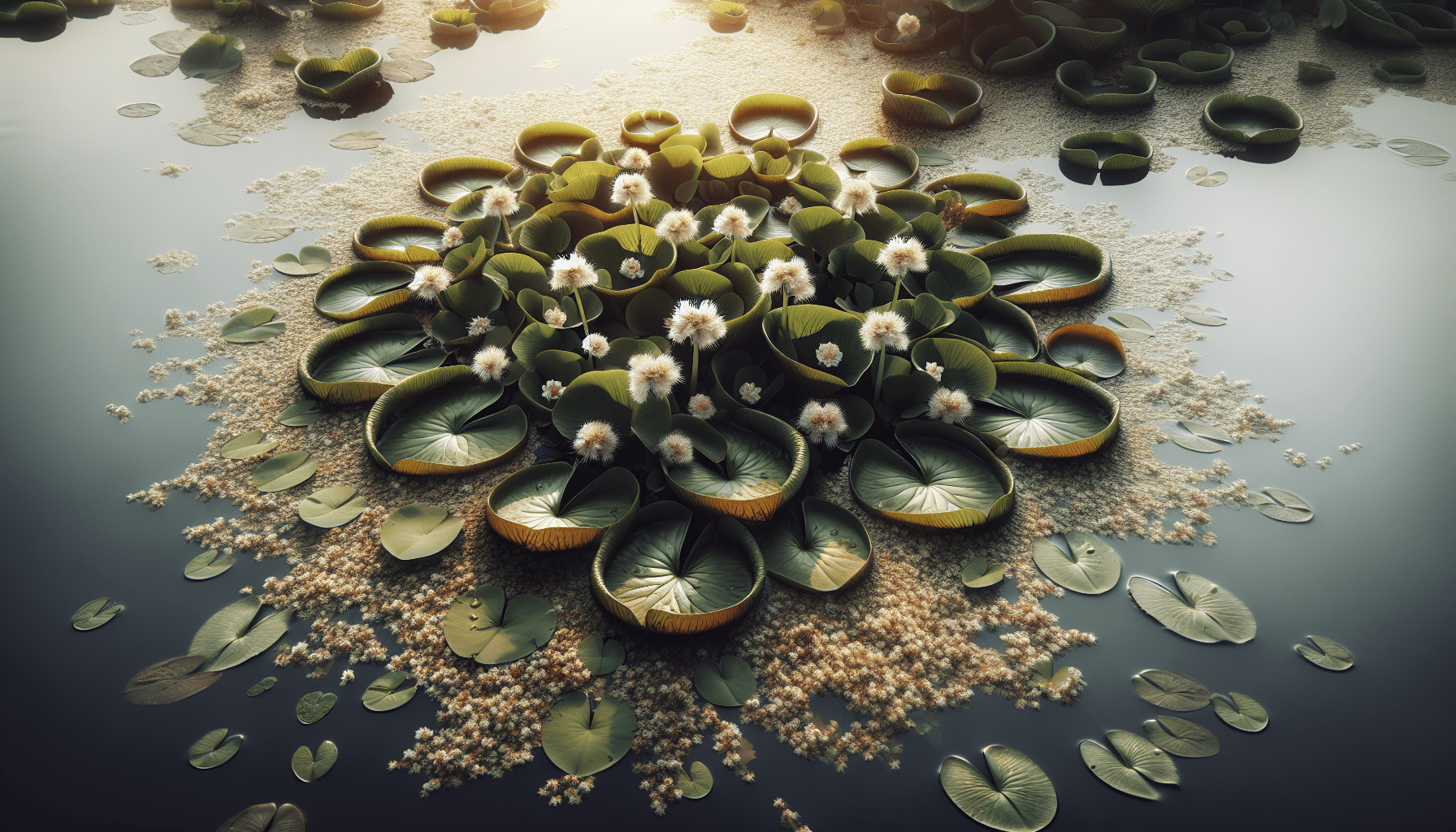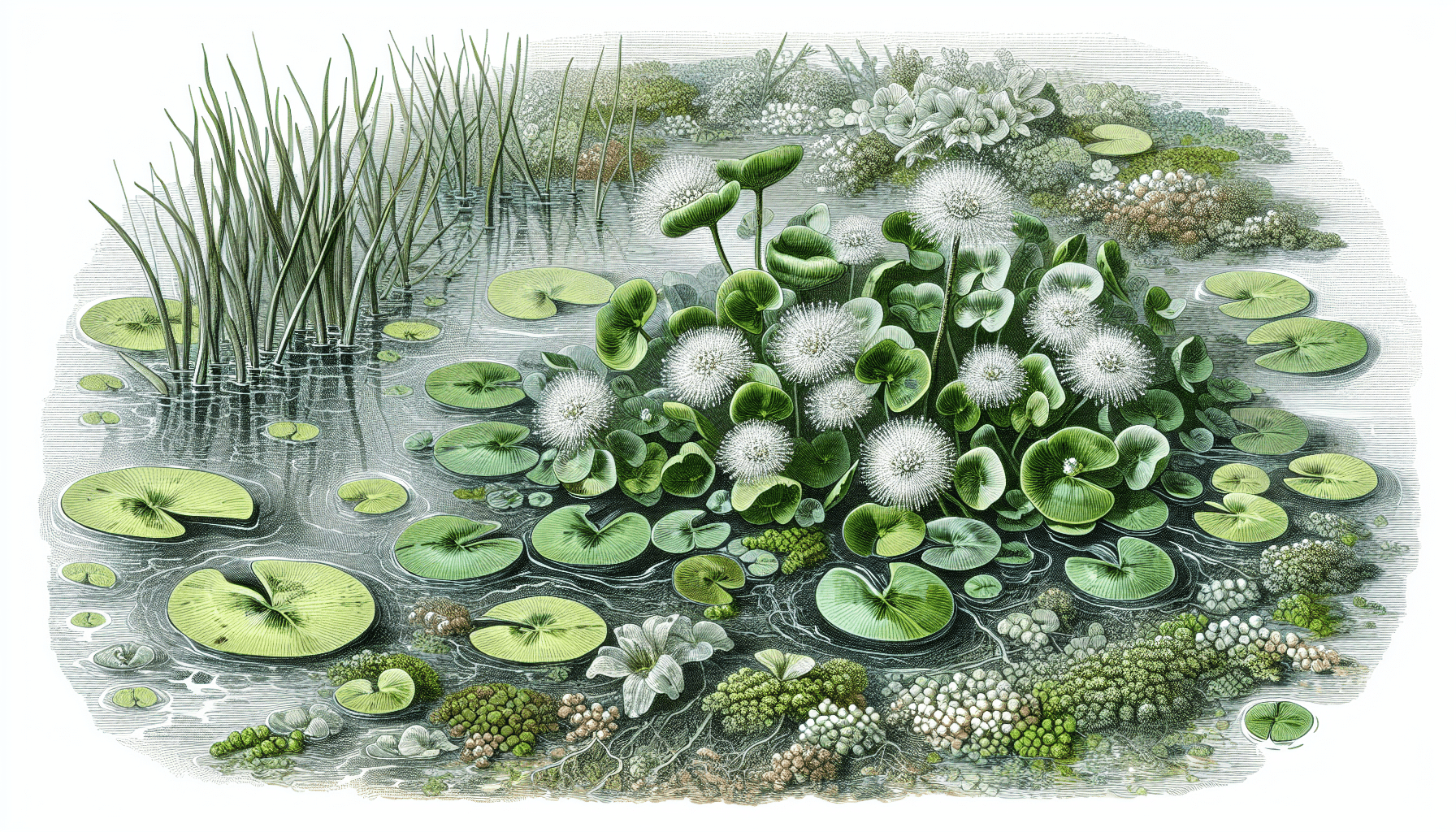In the intriguing article “What Is The Aquatic Weed Nymphoides Aquatica,” you will explore the fascinating world of aquatic botany, specifically focused on the lesser-known, yet significant Nymphoides Aquatica. Venturing into its unique morphology, geographical spread, ecological significance, and potential applications, this read equips you with a robust understanding of this obscure weed, including its role in aquatic ecosystems and how it can affect both biodiversity and aquaculture.

Definition of Nymphoides Aquatica
Nymphoides Aquatica, often referred to as an aquatic plant or waterlily, is known for its floating leaves and charming white blossoms. It is a member of the Menyanthaceae family, which includes both terrestrial and water plants. This species is unique among aquatic plants due to some specialized features that determine its survival and propagation in water environments.
Scientific explanation of Nymphoides Aquatica
Nymphoides Aquatica is a perennial aquatic herb, characterized by its floating leaves and clusters of white flowers. The plant has orbicular to reniform (kidney-shaped) leaves that float on the surface, attached by slender petioles. These leaves bear delicate five-petaled flowers that rise slightly above the water surface, reminiscent of miniature water lilies.
Commonly known names
Nymphoides Aquatica is often colloquially referred to as Banana Plant or Banana lily. These names originate from the form of its inherent rhizomes, which resemble a bunch of bananas. This resemblance has led to the plant’s widespread recognition as the Banana Plant in the aquatic trade, especially among aquarists.
Water conditions correlating with Nymphoides Aquatica
This species prefers still to slow-moving water, thriving in a range of pH levels. It is remarkably tolerant to different water hardness conditions but tends to prosper more in soft, slightly acidic water. Sufficient light encourages robust growth and blooms, although it can also adapt to moderate light conditions.
Characteristics of Nymphoides Aquatica
The unique characteristics of Nymphoides Aquatica distinguish it from other aquatic plants, embodying both beauty and functionality.
Physical attributes
Nymphoides Aquatica exhibits floating leaves that are rounded and heart-shaped, ranging from 5 to 15 cm in diameter. Its rhizomes resemble a bunch of bananas and are responsible for the plant’s nutritional storage. It features elegant white flowers with yellow centers that sprout occasionally in suitable conditions.
Growth rate and size
Under optimal conditions, Nymphoides Aquatica presents a moderate to fast growth rate. However, the plant typically remains small to medium in size, making it suitable for various aquatic environments, from ponds to aquariums.
Flowering and reproduction process
The reproduction process involves producing flowers that rise above the water surface. These flowers self-pollinate and later develop into a fruit. However, propagation is more commonly achieved through asexual reproduction where new plants sprout from the mature plant’s rhizomes.
Habitat of Nymphoides Aquatica
The natural and preferred habitats of Nymphoides Aquatica have distinct elements that contribute to its thriving presence.
Natural distribution and range
Nymphoides Aquatica is native to the southeastern regions of the United States and has since been introduced to other regions globally. It is predominantly found in freshwater environments such as lakes, ponds, and slow-rivers that have ample sunlight and a moderate climate.
Preferred water conditions
This plant thrives in slow or standing water and can endure a wide range of pH values. Optimum conditions for Nymphoides Aquatica are soft, slightly acidic water with plentiful light. However, it is resilient and capable of adapting to sub-optimal water conditions.
Compatibility with other flora and fauna
Nymphoides Aquatica typically coexists well with other aquatic species. Its floating leaves provide shaded areas for fish and other aquatic organisms. Other aquatic plants that prefer similar water conditions can also thrive alongside Nymphoides Aquatica.

Cultivation of Nymphoides Aquatica
Cultivating Nymphoides Aquatica requires understanding of certain propagation techniques, optimal cultivation conditions, and potential cultivation challenges.
Effective techniques for propagation
Asexual propagation is the most effective method for Nymphoides Aquatica, accomplished by dividing the rhizomes or separating the offset shoots from the parent plant. This method ensures the rapid reproduction and expansion of the plant within the water environment.
Suitable conditions for cultivation
Ensuring soft, slightly acidic water conditions with sufficient lighting often results in robust growth and blossom. The plant grows best at water temperatures between 20-28°C (68-82.4°F) and prefers a nutrient-rich substrate for its rhizomes.
Common challenges in cultivation
Challenges in cultivation include managing its rapid growth rate, which may result in overtaking the intended space. Light deficiency can also impede its growth and can cause the leaves to submerge instead of float.
Ecological Impact of Nymphoides Aquatica
The ecological influence of Nymphoides Aquatica is seen in its role in the ecosystem, its potential effects on biodiversity, and its impact on water quality.
Role in the ecosystem
Nymphoides Aquatica serves as an important habitat provider in the ecosystems where it flourishes. Its floating leaves provide shelter for a variety of aquatic species, including invertebrates, fish, and amphibians, supporting biodiversity within the ecosystem.
Impact on biodiversity
This plant contributes to biodiversity within its environments by providing physical structure and refuge, thus promoting a balanced ecosystem. However, unchecked and invasive growth can potentially displace native species leading to an alteration in biodiversity.
Effect on water quality
Nymphoides Aquatica can influence water quality positively by absorbing excess nutrients, thus minimizing the risk of nutrient overload. However, decaying plant matter may cause oxygen depletion in the water which can negatively impact aquatic life.
Economic Impact of Nymphoides Aquatica
The economic impact of Nymphoides Aquatica is seen in commercial landscaping, the aquarium trade, and the potential financial implications of its invasive growth.
Use in commercial landscaping and decor
Its aesthetic appeal makes Nymphoides Aquatica a popular choice for water gardens, ponds, and landscapes. The plant’s ability to generate shade also reduces water temperature fluctuations, benefiting other aquatic plants and animals.
Value in the aquarium trade
Nymphoides Aquatica holds significant value in the aquarium trade. Its fast growth and low maintenance make it an excellent choice for beginners. Moreover, its compact size, floating leaves, and attractive blooms enhance the aesthetic appeal of aquariums.
Potential negative financial implications
Despite its benefits, uncontrolled growth of Nymphoides Aquatica can lead to financial implications. The costs associated with its removal and control in natural water bodies and the potential damage to native ecosystems can have significant economic impacts.
Management and control of Nymphoides Aquatica
Management of Nymphoides Aquatica involves preventive steps and containment methodologies. Mechanical, biological, and chemical control strategies can be deployed.
Methods of prevention and containment
Prevention and containment of Nymphoides Aquatica requires monitoring and early detection of invasive growth. Regular removal of excess plants helps to keep their population in check.
Mechanical, biological, and chemical control strategies
Mechanical control involves the physical removal of the plant. This includes uprooting or cutting and removing the visible parts of the plant. Biological control leverages natural enemies to control the growth. Chemical control utilizes herbicides specific to the plant, but this method requires careful implementation to prevent harming non-target organisms.
Effects of human intervention
Human intervention is crucial for managing Nymphoides Aquatica, especially in areas where it is considered invasive. This may involve the enforcement of regulations limiting its cultivation and distribution to protect native ecosystems.
Nymphoides Aquatica in Aquariums and Ponds
In aquariums and ponds, Nymphoides Aquatica serves several key roles, notably in aquascaping, maintenance, and compatibility with aquatic life.
Benefits for aquascaping
Nymphoides Aquatica offers a variety of benefits to aquascaping. Its floating leaves give a natural look to the aquarium and provide a sanctuary for fish, while its flowers add color and charm.
Maintenance in an aquarium or pond environment
In terms of maintenance, Nymphoides Aquatica is quite straightforward to care for. Regular monitoring and removal of excess leaves can prevent overcrowding and maintain a healthy environment.
Considerations for fish and aquatic life compatibility
Compatibility with aquatic life is another essential consideration. Nymphoides Aquatica typically integrates well with most common fish species, as it provides them shade and safety.
Scientific Research on Nymphoides Aquatica
A wealth of research has been conducted on Nymphoides Aquatica, making substantial contributions to science and paving the way for future studies.
Historical and recent studies
Historical research has established the physiological aspects, reproductive strategies, and ecological significance of Nymphoides Aquatica, among other key features. More recent studies focus on the plant’s potential as a bioindicator of water quality and its role in phytofiltration.
Noteworthy findings and contributions to science
Noteworthy findings include the plant’s resistance to various water conditions, its prolific propagation ability, and its role in providing habitat for several aquatic species. These understandings have contributed significantly to the management of the species and its cultivation in commercial sectors.
Potential for future research
Nymphoides Aquatica provides numerous avenues for future research, including its potential use in wastewater treatment, understanding its invasive behavior, and examining its impact on aquatic ecosystems in greater detail.
Legal aspects relating to Nymphoides Aquatica
While Nymphoides Aquatica is popular in cultivation, it also has potential legal implications due to its invasiveness.
Regulations on cultivation and distribution
Several regions have regulations concerning the cultivation and introduction of Nymphoides Aquatica, especially places where it is non-native and could potentially become invasive. In such cases, restrictions may be imposed on its sale, possession, and transportation.
Potential invasive status and related laws
In some areas, Nymphoides Aquatica is regarded as a potential invasive species due to its fast growth and prolific propagation. Laws relating to invasive species often involve strict regulations regarding introduction and management to protect native ecosystems.
Consequences of non-compliance
Non-compliance with the regulations relating to Nymphoides Aquatica can lead to serious consequences. These can range from fines to penalties and even criminal charges in extreme cases. Compliance ensures the protection of native ecosystems and is essential in maintaining biodiversity.
In conclusion, Nymphoides Aquatica is a significant aquatic plant, appreciated for its aesthetic appeal and ecological role. However, its potential for invasive growth underlines the need for careful management. Understanding the plant’s characteristics, ecosystem interaction, and legal aspects associated with its cultivation can lead to better management strategies, potentially reducing negative ecological impacts while capitalizing on its benefits.